Central Bank: Definition, Objectives & Functions
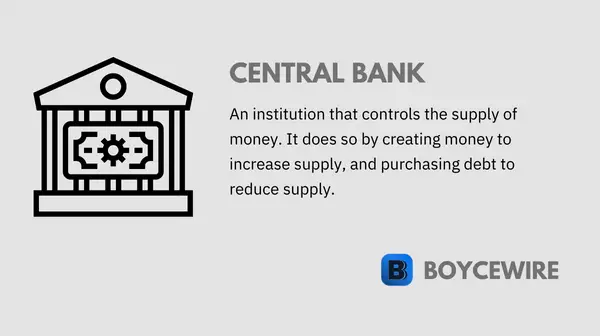
What is a Central Bank
A central bank controls the supply of money as well as how it reaches the consumer. It can not only print and inject money into the economy but also regulate how commercial banks distribute it.
The central bank controls monetary policy, which includes power over inflation, exchange rates, and the money supply. It has a number of tools by which it uses to control such. For example, it can set interest rates to control inflation, buy foreign currencies to weaken the domestic currency, and engage in open market operations by purchasing assets from financial institutions.
In turn, the central bank uses monetary tools to meet its objectives. These range from country to country, but generally include targets for inflation, unemployment, economic growth, and financial stability.
Key Points
- A central bank is in charge of monetary policy.
- The central bank’s main functions are to set the base rate, control the money supply through open market operations, set private banks reserve requirements, and control the nations foreign exchange reserves.
- The main objectives of the central bank is to maintain price and economic stability.
Introduction and History of Central Banks
In 1668, Sweden founded the first ever central bank, called Sveriges Riksbank. Its foundation stems from the failure of Swedens first bank, Stockholms Banco in 1656. Shortly after its inception, Stockholms Banco became the first bank to formally introduced banknotes to Europe in 1661.
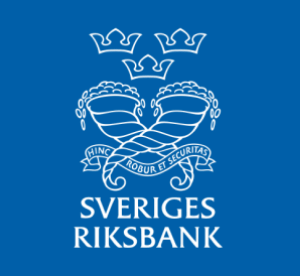
The banknote was initially very popular as it replaced coins which were heavy and difficult to handle. However, in the subsequent years, Stockholms Banco issued more banknotes than it could cover its deposits. As a result, consumers became wary of the increasing number of notes in circulation and therefore went to claim their original coins.
What happened in the 1660s was what we call a ‘run on the bank’. It didn’t have enough coins to meet its obligations and therefore went bankrupt. As a result, consumers were left with banknotes that were worth nothing. This subsequently led to the nobility of Sweden taking over the bank and the creation of the Sveriges Riksbank.
The Sveriges Riksbank took charge of monetary policy, taking official control of coinage and the supply of money. It also banned the use of all banknotes due to the severe crisis caused by its initial adaptation. However, two centuries later in 1874, it was to re-introduce banknotes into the market.
Objectives of Central Bank
The objectives of central banks have largely changed over the years, due to disastrous economic events. For example, back in the 1970s, the main goal of central banks was to ensure full employment. However, the focus on employment blinded central banks attention on inflation. Rather than maintain price stability, central banks would pump money into the economy to ensure people were being employed. Yet this came at the cost of inflation.
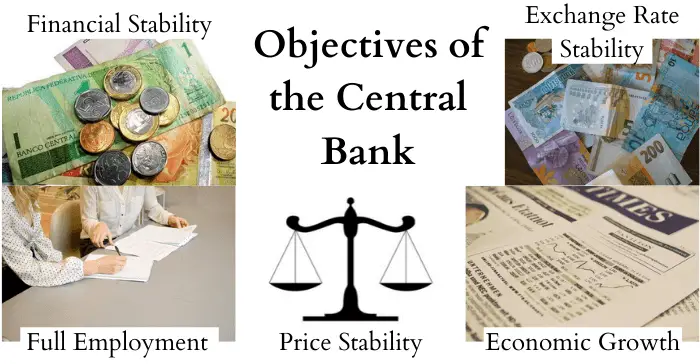
For example, in 1973, there was a massive oil crisis that was to be named the ‘OPEC crisis’. It led to a sharp increase in the unemployment rates across the developed world. In retaliation, central banks opened the taps and supplied the economy with money in the hope of boosting investment and jobs.
Whilst the plan worked, it boosted employment in the short-term, but created long-term effects. Double digit inflation occurred into the 1980s and employment equally suffered. As a result, central banks learnt that a more balanced approach is needed – one that focuses on several objectives rather than one.
Examples of the central banks objectives include:
1. Price Stability
Price stability is probably one of the leading objectives of central banks. After the high levels of inflation in the 1970s and 1980s, and the disaster that was the Great Depression of 1929, control over prices is a key element of central banking policy.
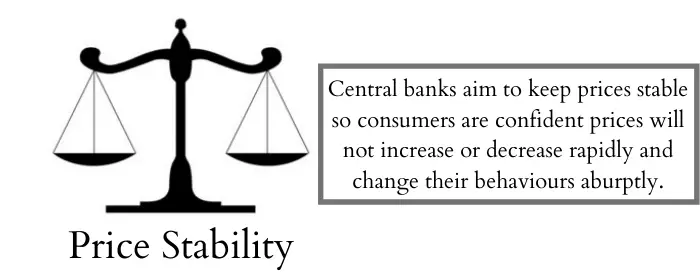
Now, through most of the developed world, the target rate of inflation is 2 percent. The reason for this is that it is high enough to encourage consumption, but not too high to cause panic buying, thereby creating a cycle of greater inflation. Yet it is not too low so as to cause an excessive amount of saving.
2. Full Employment
Going back through history, full employment was one of the leading objectives of the central bank. However, as the welfare state has expanded and the understanding of monetary policy increased, it has taken a backwards step.
Nevertheless, full employment is still a relatively important objective. Most central banks would take action if unemployment starts creeping up. Usually, this is done by lowering the interest rates to fuel cheaper credit to businesses. In turn, businesses would use the cheap credit to invest and expand its operations, thereby stimulating jobs in the process.
3. Financial Stability
The central bank often acts as lender of last resort in order to maintain financial stability. For instance, most commercial banks need short-term loans in order for them to be able to align their assets and liabilities.
On occasion, a commercial bank may have to pay a loan to another financial institution, but their assets are tied up in long-term loans and other illiquid assets. As a result, they need some short-term liquidity to meet their obligations, which is where the central bank comes into play.
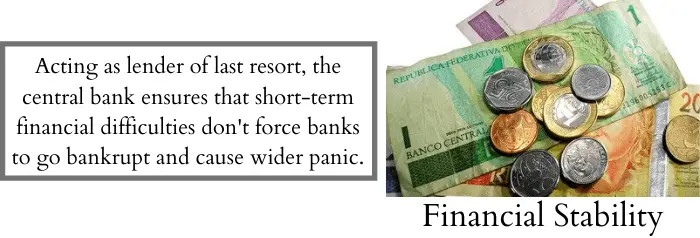
This is crucial in the private sector as some short-term mis-payments could cause severe consequences. One small short-term default may lead other institutions to stop doing business with them, and customers may start to go elsewhere. It can destroy the firms reputation and hence the confidence in it as an organisation. So the central bank plays an important role in ensuring confidence remains and banks remain stable.
4. Economic Growth
Economic growth is important to central banks as it generally means more jobs and better living conditions. When there is economic growth, it is often associated with increased business investment, improving employment, and increasing demand.
Now economic growth is an objective for central banks but is not necessarily its main one. They often have to weigh up the pros and cons, as controlling inflation and prices may be more beneficial than stimulating the economy. Nevertheless, central banks will often look to prop up the economy if they can do so whilst also maintaining price stability.
5. Exchange Rate Stability
For one reason or another, a nation may face a currency shock by which the demand for its currency declines rapidly. This may be due to a domestic political output or a financial crisis. In turn, this creates instability within the markets, which central banks look to avoid.
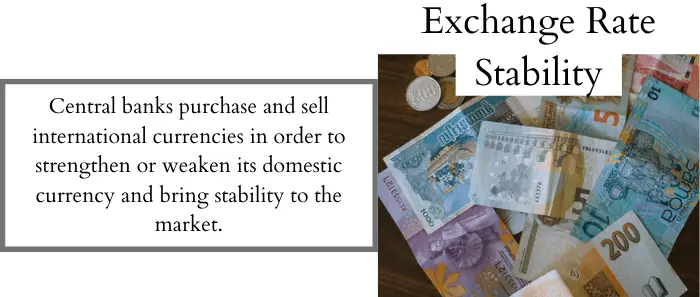
Exchange rate instability can lead to lower levels of business confidence as they are unable to adequately plan their investments or business strategy. This is an even more important factor in todays inter-connected economies that rely heavily on international supply chains.
When the exchange rate falls heavily, the central bank may look to buy the domestic currency from the exchange market in a bid to increase its demand and value. This can help create stability in the market, which could significantly affect importers, the supply chain, and exporters alike.
Functions of Central Bank
There are four main functions of a central bank. They are – setting the base rate, control the money supply through open market operations, ensure banks maintain reserves, and control the nations reserves of foreign currencies.
Base Rate
One of the central banks leading functions is the setting of the interest rate. Also known as the base rate, it sets a rate which commercial banks can borrow from the central bank. In turn, commercial banks react with higher interest rates to the public as they are paying a higher rate to the central bank.
The base rate is a useful function as it acts somewhat like a tap. By increasing the rate, borrowing from the central bank becomes more expensive for commercial organisations. In turn, loans to businesses and consumers becomes more expensive, thereby reducing the circulation of money.
By contrast, a decline in the base rate is used to stimulate demand. As debt becomes cheaper to finance, businesses and consumers demand more of it, thereby increasing the circulation of money.
Open Market Operations
Open market operations simply involves central banks creating money and purchasing financial assets with it. In recent times, it has come under the naming ‘Quantitative Easing’. The aim of which is to take away either ‘toxic’ assets as we saw under quantitative easing, or to buy up assets and free up money to invest elsewhere.
When a central bank engages in open market operations, it firstly creates cash. Then, it purchases financial assets such as government bonds and gilts, and other instruments. The cash then passes over to the financial institution that it purchased them from. This then acts as new money into the economy.
At the same time, some central banks such as the US’ Federal Reserve transfer any profits made back to the treasury. So central banks purchase government debt and when government payments include interest, these profits go back to the government anyway.
Reserve Requirements
Central banks often use reserve requirements to increase and decrease the supply of money. It does this by requiring each bank to keep back a certain percent of each deposit they take in. For instance, most commercial banks will only keep 5 cents for each dollar put in, and loan out the other 95 cents.
So if the central bank was to raise the reserve requirement to 10 percent, then commercial banks would have to keep 10 cents for each dollar, and only loan out 90 cents. In turn that means few loans going out, thereby restricting the circulation of money.
Foreign Exchange Reserves
Central banks will usually hold a significant amount of international currencies at any one point. For instance, the Federal Reserve held $41 billion in foreign currencies at the start of 2020.
The aim of which is to be able to help stabilise fluctuations in the foreign exchange market. If the US dollar was to significantly lose its value, the Federal Reserve may look to purchase US dollars with foreign currencies in order to increase its value.
As the Federal Reserve purchases more and more US dollars, it sends a signal to the market that it is in high demand, thereby strengthening its value and stabilising the market.
Related Topics
FAQs on Central Banks
The main argument for a central bank is in order for a centralised organisation to control the supply of money. This originally stemmed from the issues that occurred in Sweden when the first European banknote was put into circulation. Stockholms Banco was the first European bank to do so, yet it produce far in excess of what the market could take, thereby leading to inflation and a run on the bank.
The central bank earns money on interest from commercial banks borrowing from it. It also creates money and uses it through open market operations. These are essentially created through an electronic system that transfers money from the central bank to other financial institutions.
Any profits made are then generally transferred to the government’s treasury.
A central bank has four main functions. They are:
1. Control the Base Rate and inflation.
2. Control the money supply through Open Market Operations.
3. Maintain Reserve Requirements with private banks.
4. Ensure there are sufficient Foreign-Exchange Reserves.
About Paul
Paul Boyce is an economics editor with over 10 years experience in the industry. Currently working as a consultant within the financial services sector, Paul is the CEO and chief editor of BoyceWire. He has written publications for FEE, the Mises Institute, and many others.

Further Reading
 Second Degree Price Discrimination: Examples & Graph - Second degree price discrimination is where a firm sells at different prices based on quantity. This may include offers such…
Second Degree Price Discrimination: Examples & Graph - Second degree price discrimination is where a firm sells at different prices based on quantity. This may include offers such…  Expected Value Formula - The expected value formula is a mathematical calculation used to estimate the average outcome of a random variable, taking into…
Expected Value Formula - The expected value formula is a mathematical calculation used to estimate the average outcome of a random variable, taking into…  Binomial Distribution - The binomial distribution is a probability distribution that describes the number of successes in a fixed number of independent Bernoulli…
Binomial Distribution - The binomial distribution is a probability distribution that describes the number of successes in a fixed number of independent Bernoulli… 